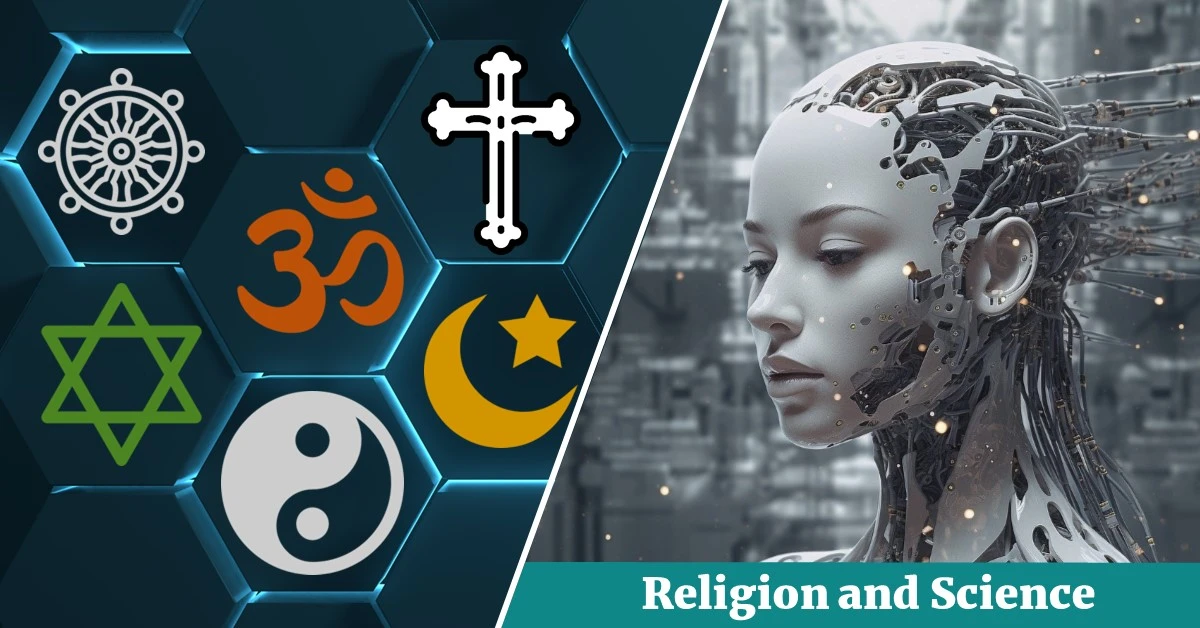Last updated on August 14th, 2024 at 12:18 pm
The relationship between science and religion has been a topic of profound discussion throughout history, and it continues to be relevant in the modern era.
Philosophers have contributed significantly to this discourse, offering various perspectives that highlight both the conflict and harmony between these two domains of human understanding.
In 13th-century Europe, Christian theology was regarded as the queen of the sciences.
“Science”, in this Aristotelian sense, was a systematic exposition of an area of knowledge which was ideally founded on self-evident or certain first principles. The first principles of Christian theology, it was thought, provide the most certain of all principles, since they were revealed by God.
Thus, theology becomes the paradigm of science. Since that time, the word “science” has changed its meaning, so that now most people would regard a science as an experimental investigation into a physical phenomenon, where precise observations can be made and measurements taken, where experiments are repeatable and publicly testable, and where hypotheses need to be constantly tested and re-assessed.
In such a context, theology is no longer seen as a science at all. There are no precise measurements in religious faith, no repeatable experiments, no public testing, and no equations which might help one to predict events accurately.
Historical Context
Historically, science and religion were often seen as conflicting worldviews, especially during periods such as the Galileo affair in the 17th century, where scientific discoveries clashed with established religious doctrines. Philosopher Bertrand Russell, in his work Why I Am Not a Christian, critiques religious dogma and asserts the primacy of reason and empirical evidence in understanding the universe. Russell exemplifies a rationalist perspective that emphasizes the potential for conflict between scientific discoveries and religious beliefs rooted in tradition.
Since the 17th century, the way we see the history and character of the material universe has been revolutionized.
In Europe at least, the Earth had been seen as the centre of the universe, which had existed for only a few thousand years. The human race had been directly created by God, and had fallen from a direct knowledge of God into lamentable ignorance. The whole universe was widely expected to be about to end at any time, and conditions of life on earth were not expected to change in any important way before then.
Contemporary Context
In contrast to conflict, many modern philosophers advocate for dialogue and mutual understanding between science and religion.
In addition to historical perspectives, contemporary philosophers continue to contribute fresh insights into the dynamic relationship between science and religion. One notable figure in this ongoing discourse is Richard Dawkins, whose book The God Delusion asserts a staunchly atheistic viewpoint, arguing that science and religion are fundamentally incompatible.
Dawkins contends that scientific inquiry and empirical evidence should be the basis for understanding the universe, dismissing religious faith as irrational and contrary to scientific progress.
Conversely, philosophers like John Polkinghorne, a physicist and theologian, advocate for a more integrative approach. In works such as “Science and Theology: An Introduction,” Polkinghorne explores the ways in which scientific discoveries can enhance theological reflections and vice versa. He proposes that both disciplines, when approached with intellectual rigor and humility, can contribute to a deeper understanding of the nature of reality and our place within it.
Ian Barbour, in his influential book Religion and Science: Historical and Contemporary Issues, proposes four models for understanding their relationship: conflict, independence, dialogue, and integration. Barbour suggests that while conflicts do arise, fruitful dialogue and integration are also possible, where scientific insights can enrich religious perspectives and vice versa.
Philosopher Alvin Plantinga, known for his work in the philosophy of religion, argues for the compatibility of science and religion by distinguishing between their respective domains of inquiry. In Where the Conflict Really Lies: Science, Religion, and Naturalism, Plantinga posits that science and religion can coexist harmoniously because they address different aspects of reality—science dealing with the natural world and religion with questions of meaning, purpose, and ultimate reality.
In the 20th century, most scientists see the universe as having existed for fifteen billion years or more, human beings as having evolved from simpler forms of organic molecules, and the Earth as a small planet on the edge of one galaxy out of billions in the universe. Moreover, technology has changed the way human beings live quite radically, so that instant communication, global travel, medical intervention, and increasing control of reproductive processes have transformed the conditions of life for millions of people.
The impact of scientific method, scientific discovery, and technological change has been such that some have argued that religious faith has become wholly outdated.
Instead of believing on authority, one has experimental proof, and instead of hope for a better afterlife, one has hope for progress through technological change.
So, one consequence of the scientific revolution has been the claim that religious belief belongs only to past history. Science replaces religion. That is the first main view of the relation between science and religion. Other responses, however, are possible.
A second view is to point out that religion and science are concerned with different areas of human life. They do not really conflict, because they talk different languages. Science is concerned with the physical, the measurable, and the repeatable, and there is plenty of that in the universe.
Religion is concerned with the spiritual, the immeasurable, and the uniquely individual. It is concerned with an infinite spiritual reality, and with the sorts of conscious relationship human beings can have with it. These are more like personal relationships, where one is not concerned with measuring, analysing, and experimenting. In a personal relationship, one is concerned with understanding, responding, empathizing, and cooperating. It would be quite inappropriate to regard a person one loves as a subject for dispassionate experiments. One would be more concerned with their uniqueness, their personality, and their thoughts and feelings.
So in religion one might be concerned with a spiritual dimension to the universe which is rather like a personal dimension. It would not be a proper subject for scientific experiment. Poetry and art might be better vehicles for evoking the sense of such a Supreme Spirit. On such an understanding, science and religion are complementary activities. One could easily practise both, and there would be no conflict between them. Science and religion never meet. That is the second main view of the relation between science and religion.
To many people, this is not wholly satisfactory. Christian faith does, for instance, make claims that God has a purpose in creating the universe, and that this purpose will be realized. God acts in history, in the history of Israel, in Jesus and in the Church. God does make a difference to how the universe is, and so conflict is possible between those who claim that science rules out divine action and those who affirm such action in the universe.
In this case, one needs to distinguish carefully between the specific experimentally established data of the sciences, and the very broad generalizations that are often extrapolated from them. For example, it is established that the law of gravity operates, other things being equal, on any two material bodies.
But it is a generalization from this to say that the law operates without exception everywhere in the universe. Indeed, such a generalization would be inaccurate, according to relativity theory, in the areas of the very small and the very large. In any case, as Isaac Newton thought, there might be many cases where the law does not operate, because the action of God modifies it—for instance, in causing miracles.
There is a dispute between those who think that miracles occur, or that God acts in the universe providentially and those who think there are no exceptions to the laws of nature, or that those laws—for example, the laws of mutational change in evolution—do not suggest or even allow any purposive “interference” from outside.
There are possible disputes about the facts. But these are not disputes which seem to be conclusively resolvable by any specific scientific experiment.
They are disputes between a philosophical generalization from science, a “world-view” that everything is governed by seamless causal laws, and a different world-view, that there is an ultimate spiritual reality which directs the course of the universe, and which influences causal mechanisms in the universe in various ways, which are scientifically undetectable or at least usually undetected. Such disputes are very complex and wide-ranging. Perhaps the most one can do is try to arrive at a balance of probabilities.
So, one person might think that the laws of physics are so well-established that it would be irrational to believe in exceptions to them. But another equally well-informed person might think that the elegance and intelligibility of the universe strongly suggest a wise creator, so that it would be irrational not to allow for the possibility of that creator causing particular and unique events in the universe, given a good enough reason. The third main view of the relation between science and religion is that they can conflict, but it may be possible to revise one or the other so that they do not.
Many religious believers might protest that it sounds odd to make religious belief a matter of balancing probabilities in this way.
They may say that religion is founded on an experience of God which challenges them to turn away from greed and pride, and accept the grace, the love, of God. One has to commit oneself in trust to the God who reveals himself in such ways.
So God is not just a probable hypothesis, but a living, experienced reality. For the religious consciousness, that is probably correct. This is the strength of the second view, that religious faith is a matter of vision and commitment, not of speculative theories. Yet that vision needs to be consistent with our understanding of the nature of the universe. Such understanding has been largely built up by the sciences. For that reason, it is important to test one’s vision against the scientific understanding, and to try to ensure that there are no insoluble conflicts.
This would move one towards the third view. One thing has become clear in the story of how religion and science have interacted over the past three hundred years. The experimental sciences give us the best grasp of the truth of how the material universe is. Ancient religions have to adapt to that. The crucial question religion poses is whether there is a spiritual dimension to the universe, which is not as such accessible to the methodologies of science, but which is compatible with what the sciences tell us.
This question has not been resolved to the satisfaction of everyone, and perhaps it never will be.
Some traditional believers would insist that it is modern, especially evolutionary, science that needs to be revised, where it conflicts with traditional religious claims.
But religious views which take science seriously will have to place their beliefs in the context of an evolutionary world-view, for which human beings are one evolved species on a small planet in a tiny part of the universe. They will probably need an account of evolution which sees it, not as a purely random process, but as compatible with some sort of cosmic purpose or goal—at the least, a propensity for evolving consciousness.
That will have some impact on the way evolutionary theory is interpreted, and it will also change many traditional ways of putting things in religion. But it may be that religions testify to the existence of a transcendent value and reality, of which humans can become conscious through prayer and meditation, and which it may even be the goal of human life to know and love more fully.
Theology, the reflective aspect of religion, may no longer be the queen of the sciences. But it may keep alive intimations of transcendent meaning and value without which the sciences would limit human vision of what the universe really is.
That is what religious believers will think. Scientists as such will not oppose them, though certain sorts of generalization from science undoubtedly pose problems for many sorts of religious belief. So these two basic human activities will unavoidably influence one another in many ways, and the exploration of the relationship between them remains one of the most fascinating and unresolved areas of human enquiry. Ethical and Moral Dimensions
Beyond metaphysical and epistemological considerations, the relationship between science and religion also intersects with ethical and moral dimensions of human life. Philosopher Martha Nussbaum, in The Fragility of Goodness, explores how religious traditions and philosophical ethics can inform one another in addressing fundamental questions of justice, compassion, and human flourishing.
Nussbaum argues that a dialogue between scientific insights and ethical considerations grounded in religious and philosophical traditions can lead to more robust ethical frameworks for addressing contemporary challenges.
Cultural and Societal Implications
The impact of science-religion interactions extends beyond theoretical debates into cultural and societal realms. Philosopher Charles Taylor, in A Secular Age, examines the shift in Western societies from a religious worldview to one characterized by secularism and scientific rationalism. Taylor’s analysis underscores the complex interplay between scientific progress, religious belief systems, and the formation of cultural identities in the modern era.
Science and Religion: Towards a Synthesis
The relations between science and religion in the modern world are marked by a rich tapestry of perspectives—from conflict and independence to dialogue and integration. Philosophers continue to play a crucial role in navigating these interactions, offering frameworks that challenge simplistic dichotomies and encourage nuanced understandings.
While some philosophers like Dawkins emphasize the potential for conflict between science and religion, others such as Polkinghorne and Nussbaum advocate for dialogue and integration, suggesting that both domains of inquiry can enrich our understanding of reality and human experience. As we move forward, the challenge lies in fostering respectful dialogue and mutual learning between scientific and religious communities, recognizing the complementary insights they offer into the mysteries of existence.
Conclusion
In conclusion, the relations between science and religion in the modern world are characterized by a rich and evolving discourse that spans conflict, dialogue, and integration.
Philosophers play a vital role in this discourse, offering diverse perspectives that challenge simplistic dichotomies and promote a deeper understanding of the complementary insights that science and religion can offer. As we face the future, fostering an open and respectful dialogue between scientific and religious communities will be essential for addressing the complex and interconnected challenges of the modern world.






